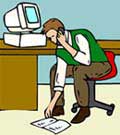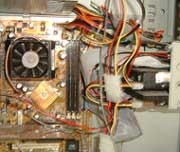|
Projects list
Dark side of digital technology
A Thai student presentation at a school in Bangkok (12 March 2003)

- Definition
- What is inside ?
- Disposal and recycling
- Double standard
- Environment
- Health (physical and psychological)
- Social (digital divide)
- Suggestion
Definition
Digital technology is a very diverse business. It is the technology used to create, store, exchange, and
use information. Telephony and computer technology; transmission and management of singal, message, image,
motion picture, sound and any kind of information are included. Examples are mobile
phones, personal computers, printers, fax machines, control elements, electric and electronic parts used in
businesses and military.
The forces that drive the information revolution is also part of the digital business.
 What is inside ?
What is inside ?
When you look at a name plate on the cover of a personal computer there are names like hard disk drive, floppy disk
drive, monitor, mother board, back up battery, CD driver, CPU, etc. Do you know what are these parts made of ?
Computers contain scores of toxic materials that pose health threats to production
workers, people living near the factories where computer components are produced or
sites where old computers are dumped, and people who recycle them without
adequate protection.
These toxic materials include lead, cadmium, barium, brominated flame retardants,
highly flammable plastic, mercury and gases.
Disposal and recycling
With the currently available technology, knowledge and safety measure some parts of old and used digital equipment
can be recycled. However there are still many parts that pose known and un-known risks to the recycling industry.
Therefore mountains of obsolete computers, monitors, and printers (e-waste) are dumped
in places especially developing countries with severe environmental, health and social consequences.
Double standard
The huge difference between nations in income level, education and awareness, technology,
so-called international reputation and power also produce problems which are difficult to solve.
In countries and states (in most cases these are the developed countries) where laws and regulations
are properly updated and enforced according to the technological development and dangers they bring,
the companies are forced to take full financial and physical responsibility for their products throughout their
life cycle, including end of life recycling, reuse, or disposal.
The same companies are dumping the e-wastes in the countries and states (in many cases they are the
poor countries) for recycling or land fill.
Even in a single country where there is a law banning the damping of e-wastes inside the country, there may be
no law to ban the export of e-wastes to other countries. Double standard exist between countries and
within companies.
There are also delicate problems such as agreement on the definition on the words such as "e-waste" and "re-cyclable items".
 Environment
Environment
Environment is the place in which you live and work. Air, water, soil and the things below the soil, the rivers and
seas and oceans, homes and offices, roads, trees, plants, animals.
In fact the environment is what you eat, where you live and you yourself.
E-wastes produce polluted water, kill fish and wildlife and people. They damage narural resources.
Management of e-wastes and other wastes such as plastic packages is very costly and risky.
Health
In addition to the health risk of contact with e-waste, there are health problems connected to the too much
use of digital technology such as computers. Long continuous use of computer effect blood and
nervous system, reproductive and development system. There are also cancer and genetic impacts,
repetitive strain injury to the long time users.
On the other side there are cybersexual addiction, cyber-relational addiction, net gaming,
information overload, and computer addiction. People have problems of less productivity,
marital problem, sexual addiction, isolation, and internet abuse.
Social (digital divide)
The world can be divided into people who do and the people who donít have access to-and the
capability to use-modern information technology, such as TV, telephone, or the internet.
The gap between poorest nations and the most developed countries is too wide to bridge. For example
tele-density (fixed and mobile phones) in a poorest country is only 1% while it is over 125% in a most developed
country. In the area of information communication (internet, telephone, TV, health care and education) the gap appears
to be widening at a high speed, and poses tremendous challenges.
Suggestion
Open your eyes and ears, learn the technology, its danger side and ways to prevent troubles. Support true
environmental protection program, donate working computers, dispose or recycle properly.
Use computers efficiently, to use longer or purchase fewer computers.
Support the programs bridging digital divide.
 Transfer good information and education to those who do not have access to communication equipment.
Transfer good information and education to those who do not have access to communication equipment.
Manufacturers have started to use harmless materials in production of equipment. Find out the news and information
and support them.
Take regular physical exercise. Let your eyes take rest frequently. Eat healthy fresh foods.
|

 What is inside ?
What is inside ?
 Environment
Environment
 Transfer good information and education to those who do not have access to communication equipment.
Transfer good information and education to those who do not have access to communication equipment.
